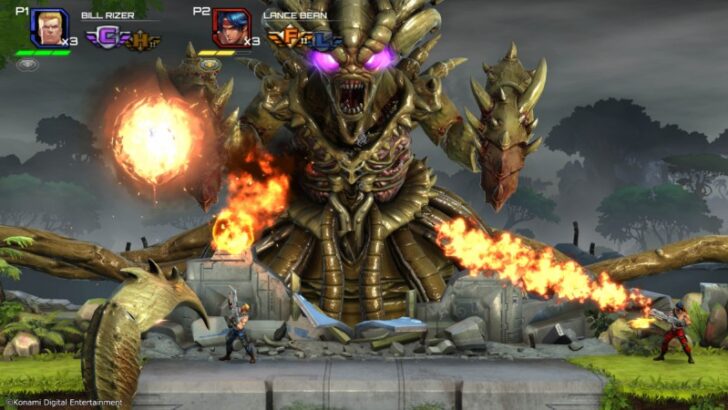Reviewed on:
Switch
Platform:
PlayStation 5, Xbox Series X/S, PlayStation 4, Xbox One, Switch, PC
Publisher:
Konami
Developer:
WayForward Technologies
Release:
March 12, 2024
Rating:
Teen
Once a tentpole franchise in the popular run-and-gun subgenre of action games, Contra has experienced a stark downturn in recent decades. Konami’s (mostly) side-scrolling shooter franchise has often gone long stretches without a release, and the games that have come out in recent years range from middling to downright bad. With Contra: Operation Galuga, Konami taps renowned retro-style developer WayForward, best known for its work on the Shantae series, to bring the once-renowned series back to its roots. While far from a one-to-one remake, Contra: Operation Galuga effectively captures the spirit of the original game while modernizing just enough to make for an exciting, albeit short, adventure.
The core conceits of the original Contra carry forward into this modern reimagining. Smooth platforming, solid 2D gunplay, and a wealth of power-ups are at your disposal as you take on a tough-as-nails campaign consisting of eight missions. The spread gun power-up remains extremely effective, but I adored blasting through hordes of enemies with items like the flamethrower, heat-seeking missiles, and lasers. Operation Galuga ups the ante by allowing you to stack power-ups, meaning the upgrade becomes more potent if you gather duplicate power-ups. On top of that, if you find your back against the wall or you’re about to pick up a new power-up, you can sacrifice your existing weapon to unleash a powerful Overload ability. These ultimate-style abilities provide aid in the form of additions like drones, shields, and clusters of attacks. I loved balancing the risk and reward of maximizing damage and effectiveness in tough combat scenarios.
WayForward proves supremely capable of delivering stellar gameplay and strong level design within the confines of the established classic Contra games. By using the original levels more as guides than slavishly adhering to their layouts, WayForward competently injects big setpiece moments late ’80s technology could only dream of. Though the initial level and the ascent up a waterfall hold a special place in my heart due to nostalgia, I most enjoyed when WayForward added elements like a hoverbike to the base mission, or inserting a train into the ice level. Though there are only eight missions in Story Mode, these different formats go a long way to diversifying the experience, as do the multiple unlockable characters, each with unique special abilities. However, I am disappointed in the lack of 3D-style shooting gallery levels that were so iconic in the original NES game.
Additional enemy types, bosses, and areas to explore pad out the stages, and unless you hone your skills, it will be an uphill battle to get through Story Mode. While the term “bullet hell” wasn’t yet coined when Contra hit the NES in 1988, that term can retroactively be applied to certain sequences of that title. Those same sections have been reimagined and easily earn that designation in Operation Galuga. On various occasions, it took me multiple attempts to understand what I even needed to do to push through a difficult situation and, even more still, to execute the plan. True to its source material, Operation Galuga is a hard game.
Thankfully, you can adjust the difficulty in a couple of ways to make it more approachable. In both Story and Arcade Mode, you can choose a difficulty setting and decide if you’d rather have your character operate on the one-hit kill style of the original game or if you want HP associated with each life. These modernizations drastically improve the experience, though don’t expect these settings to make the missions a walk in the park.
These settings also don’t impact the aptly named Challenge Mode, which gives you 30 bite-sized objectives to complete. You can try your hand at speedrun, survival, boss battle, and weapon-specific challenges, but outside of the initial attempts, I never felt compelled to return to these. Arcade Mode offers a similar experience to that of Story Mode, but minus the superfluous cutscenes and narrative character restrictions. You can also play Arcade Mode in four-player co-op instead of the two-player limit in Story.
All these activities reward you with credits, which are used to buy perks from the in-game shop. These equippable boosts offer upgrades like additional HP, extra lives, new characters in Arcade Mode, and even bonuses like additional soundtracks and a fast-paced Speedrun Mode. Unfortunately, the perks are expensive, and I grew tired of farming credits long before I reached the amount I needed for the perks I was eyeing. Even entering the famous Konami Code just adds an expensive, purchasable perk in the shop.
Though the stages are much longer than their original forms, sometimes clocking in at around 15 minutes, playing through Story Mode only takes a couple of hours. Still, Contra: Operation Galuga packs a whole lot of action into those hours. When you add the more flexible Arcade Mode and difficult Challenge Mode, Operation Galuga is an admirable modernized reimagining of one of the most influential games of the late ’80s.
Score:
8
About Game Informer’s review system









